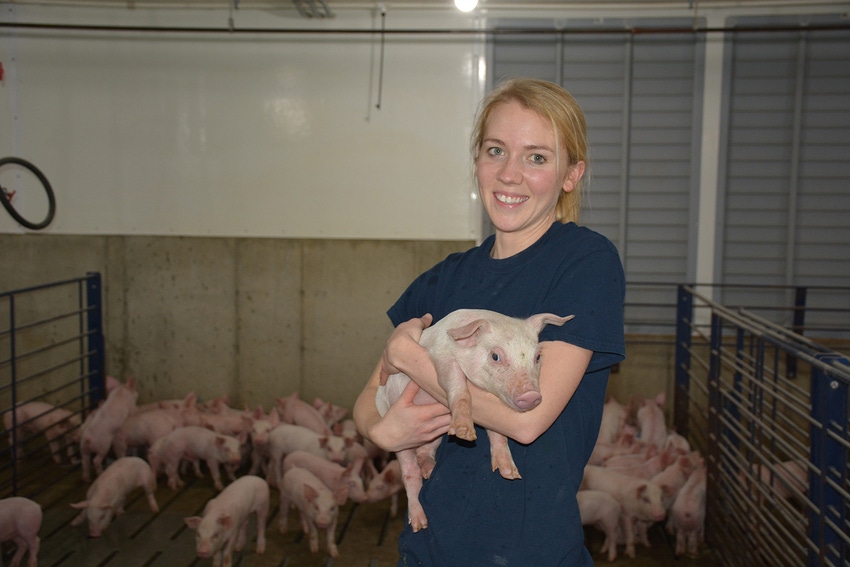While Pietig had some experience working on a local sow farm in high school, it was really through her husband that she became immersed in pig farming.

Melissa Pietig will admit when she first took on the manager position at the Leavenworth Livestock Research Center near Sleepy Eye, Minn., last year, she was entering uncharted water.
“In farming, you learn to prepare yourself for change or curveballs,” Pietig says. “I had livestock experience, but not nursery or finishing pigs, and it was definitely different than my dairy experience.”
This week I had the privilege to meet the 29-year-old, who hails from a 90-cow dairy farm and holds a dairy science degree from South Dakota State University (Go Jacks!). Her first job out of college was working at a 600-cow dairy, doing herdsman work, working with fresh cows and managing the embryo transfers, when the opportunity arose to manage the 2,500 wean-to-finish research center.
While Pietig had some experience working on a local sow farm in high school, she jokes that it was really through her husband that she became immersed in pig farming.
“I kind of fell into the pigs by default with Jamie,” Pietig says.
A swine nutritionist with Hubbard Feeds, Jamie, is actively involved in the research conducted at Leavenworth. Since the barn opened its doors in April 2017, Hubbard has led trials on stocking density, an Alltech feeding program called Blueprint and phase feeding lactose in the nursery.
Which all means as a contract grower for Schwartz Farms, Pietig not only had to learn everything she could about managing a wean-to-finish barn successfully, she also had to learn how to collect data and conduct feed research.
“What was really challenging to me was trying to anticipate those curveballs without really knowing what they might be. It could be anything from learning to change a motor and the mechanics of the feed system. It could be at the pig level, or it could be how to navigate the technology in the barn,” Pietig says. “There hasn’t been anything our team has come across that we haven’t been able to overcome though! We really do have an excellent support system through the people we work with.”
Before the first unload of nursery pigs, Pietig spent six weeks with one of Schwartz Farm’s trainers, visiting other producers’ barns and learning what they do every day to take care of nursery pigs. Now, a barn supervisor for Schwartz Farms comes twice a week when the pigs are in the nursery, and once a week when in the finisher. The service manager does walk-throughs, looks at ventilation, examines pig health, helps with the marketing schedule and gives suggestions if changes need to be made.
The 2,500-head barn is double-stocked with pigs for the nursery phase, which means Pietig has twice as many pigs to care for until they reach about 50 pounds, when half of them are moved out to a finisher barn. While the 5,000 nursery pigs may seem like a lot to handle for the novice pork producer, Pietig says it’s that support from Hubbard Feeds and Schwartz Farms that has made the center so successful.
“If you have great people to work with, you are going to be successful,” Pietig says.
The move to pig farming has also been beneficial for the Pietig family, which includes their daughter and son, ages 4 and 2. They have also been able to still be active in her family’s dairy operation (now at 250 cows), and also raise about 700 head of beef cattle per year.
“We wanted to be in the area we grew up, we wanted to raise our kids on the farm and we wanted to be able to do something that would get the whole family involved and carry that forward for our kids,” Pietig says.
The young producer also recognizes she is in a unique position in the industry.
“We have this family aspect of it that is really cool, and we get to be a part of agriculture, but then let’s take it one step further. I mean we are not just producing food for people, we are also changing the ways we feed pigs,” Pietig says. “Anything that I do here might impact the entire industry. If we can get one more pound of bacon, nobody is going to complain about too much bacon.”
About the Author(s)
You May Also Like




